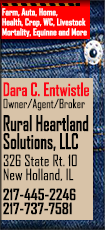|
 Observe what kind of soil you have since some
trees do better with certain soils. For example, for alders and
poplars, a wet soil is preferred, while maples and box elders can
thrive in dryer soils. Observe what kind of soil you have since some
trees do better with certain soils. For example, for alders and
poplars, a wet soil is preferred, while maples and box elders can
thrive in dryer soils.
A conversation with the local county extension office may lead to
recommended trees for your area. For example, a search of the
University of Illinois Extension site for Logan County and
surrounding areas shows American Lindens and Northern Catalpas are
two large trees that do well in our climate. Oaks and Maples also do
well.
You can purchase oaks, maples, and other large trees at the
Allsworth Christmas Tree Farm southeast of Mount Pulaski.
In addition, finding a nursery that sells mature trees will likely
provide some guidance both for tree choices and planting guidelines.

Certified arborists Mark Chisolm and Melissa LeVangie share several
specific tips on what you should look for in buying good quality
trees.
LeVangie says when you look over the trees, you should examine the
root system to make sure roots are not damaged, twisted, crushed or
torn, but are cut cleanly. Circling roots can also be problematic as
they may kill other roots or smother the stem as the tree grows
Whether the tree is in burlap or in a container, you should be able
to see the trunk flare, which is the base that connects to the
roots. The root ball should be ten to twelve times the trunk's
diameter when measured six inches above the flare. If this root ball
is too small, the tree may not survive.
Make sure you check the trunk of the tree for cracks, wounds, cuts
from poor pruning and injuries from insects. Cracks can be present
for years before they cause trees to fracture.
Inspect the branches to see if they are spaced evenly or attached
strongly to the trunk. If the branch and trunk are squeezed
together, it may later lead to broken or cracked branches especially
during storms. Too many branches at the same level on the trunk may
also cause problems.
Chisholm says a tree with well-spaced branches, crack free trunks
and a good root system is more likely to do well.
See the tips for buying good quality trees at
Tree Care
Tips: Buying High Quality Trees
Gardening specialist Jessica Smith says you need to plan where to
plant the tree and make sure you have an area large enough to that
will allow for growth. You do not want to have a tree that can grow
up to 60 or 70 feet in a spot that can only handle trees around 20
to 30 feet. Similarly, a tree that spreads over 50 feet may encroach
upon buildings and open areas where sunlight is desired.

Make sure you find a place to purchase high quality trees that are
shipped, unloaded, and cared for correctly with a staff who can
guide you through the process of planting the trees.
Ask them about any problems that arise and address concerns such as
dry leaves. You might want to avoid the lower priced trees that are
on clearance as they may be more likely to have problems.
See more advice on purchasing trees at
Growing &
Caring for Trees : How to Buy Shrubs & Trees
Deciding on the best tree for your yard requires knowing about size
and shade. Landscape Contractor Roger Cook from 'This Old House'
shows how to pick and plant a tree that is right for your yard by
figuring out how tall and wide the tree will get and how much sun it
needs.
Call JULIE before choosing the spot so you do not hit any utilities.
The hole you will put the tree in should be twice the diameter of
the what is wrapped in burlap, so make sure to measure and mark the
area so you dig out enough space.
To find out how deep the hole should be, measure from where the
roots flare out from the trunk.
Once the tree is where you want it, you can cut the burlap and
loosen the roots of the ball. Ensure that none of the roots are
wrapping around the trunk.
Adding compost, super phosphate and fertilizer are helpful, too.
Once the dirt is in, give it a good watering right away saturating
the new soil. Cook recommends putting special bags that hold water
around a tree for a couple weeks to keep it moist.
Mulch around the tree will help keep the weeds
down. How to
Plant a Large Shade Tree
Jay Golberg in his article “How to Buy Big Trees” says you need to
figure out “whether the trees you would like to plant should be
container trees or balled and burlapped trees. Large trees in a
plastic or wooden container usually have more roots intact than
balled and burlapped trees because they were probably dug from the
ground as long as one year before.”
[to top of second column] |
 Tips for planting
Check the height of the ball of the tree and measure for the same
depth in the hole. You want to the top of the soil ball level with
the surrounding soil, not elevated or sunk.
Once your hole has been prepared be sure to add water to the empty
hole. After water has drained re-measure the depth of your hole, you
may need to add a little more soil.
Before placing the tree, prepare a soil mix using the soil that has
been removed from the hole. Knecht uses a mixture of dirt, sand and
manure to help with growth.
To plant a balled and burlap tree, some landscapers use a machine
with an auger and jaws to pick up the tree as Leif Knecht of
Knecht’s Nurseries and Landscaping does.
The tree must also be set in straight.
Remove the burlap and twine, though you can leave the wire basket
because it will eventually corrode. Backfill with your soil mix when
you have the tree adjusted.
You will need to create a dike with mulch and water your new tree
about twice a week. Mulch over they whole surface of the tree ball.
It should be thick but not touch the trunk of the tree so it does
not cause the bark to rot.
See the planting process at
How to plant a
balled and burlapped tree
When transplanting large trees from pots, you can start by cutting
off the bottom of the pot and then put the pot in the hole by
grabbing the handles of the pot to make it easier to lift. Once the
pot is in the hole, you can rotate it until you have it set how you
want then cut one side of the pot and pull the pot away from the
roots.

Fresh soil mixture can be poured around the tree’s soil ball and
lightly tamped in to remove air pockets. Soil should not added over
the surface of the tree's soil ball.
Once the tree has been planted, give it plenty of water.
To see the process of transplanting a tree from a pot, watch
Transplanting
Large Mature Trees From Pots Made Easy
Planting containerized or ball and burlap trees will get you a good
start, but you may suffer from tree envy if you drive down streets
and see mature trees in yards which provide ready shade and mature
grace and beauty. You won't find those kind of trees for sale at a
big box store, but there are specialized nurseries which grow trees
on and have the right equipment to transplant them to your yard.
For instant shade, you may desire trees with heights up to sixty
feet and trunk diameters up to fourteen inches. These can't be dug
by hand or transported in your pickup truck since the root ball may
weigh as much as 3,200 pounds.
A special machine called a Vermeer Tree Spade is utilized for these
bigger trees. It has three or four huge steel spades mounted
opposite each other either in a triangle or square shape, powered by
hydraulics. This whole apparatus is mounted on a front-end loader,
or on the back of a special truck so that it is mobile. This machine
first comes to your house, and with these powered spades digs a hole
for the purchased tree, leaving a gaping crater. It returns to the
nursery to discard your soil, and opens the cradle to put the
digging spades around the tree to be transplanted. It then plunges
the blades into the ground hydraulically, and then raises up, with
soil ball and tree intact. Some say the tree doesn't even take
notice that it has just left the nursery.
Watch the
process of planting a huge tree with a hydraulic tree spade
The mounted tree spade then travels to your home with the tree in a
horizontal position, rolls to the spot with the gaping hole
previously dug, and gently puts the new tree in the hole, matching
up the soil ball to the cuts in the ground. No change in grade,
after watering it looks like the tree has always been there: instant
shade.
Contact specialty tree nurseries across the state offering this
service and large specimen trees.
If you plan ahead and follow the advice of these professionals, your
trees are more likely to thrive.
Successfully planting and nurturing a big tree
will bless the next generation and your own as well.
|